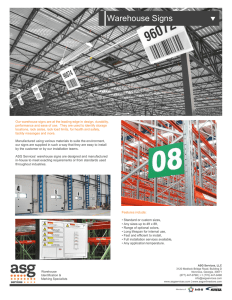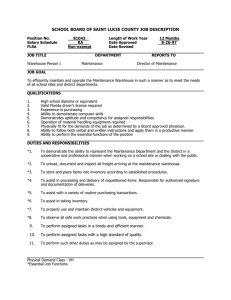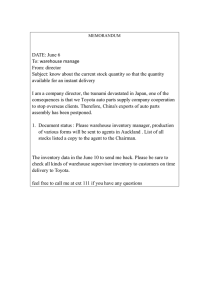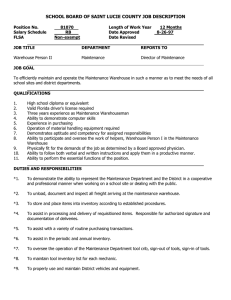Storage Space Utilization
advertisement
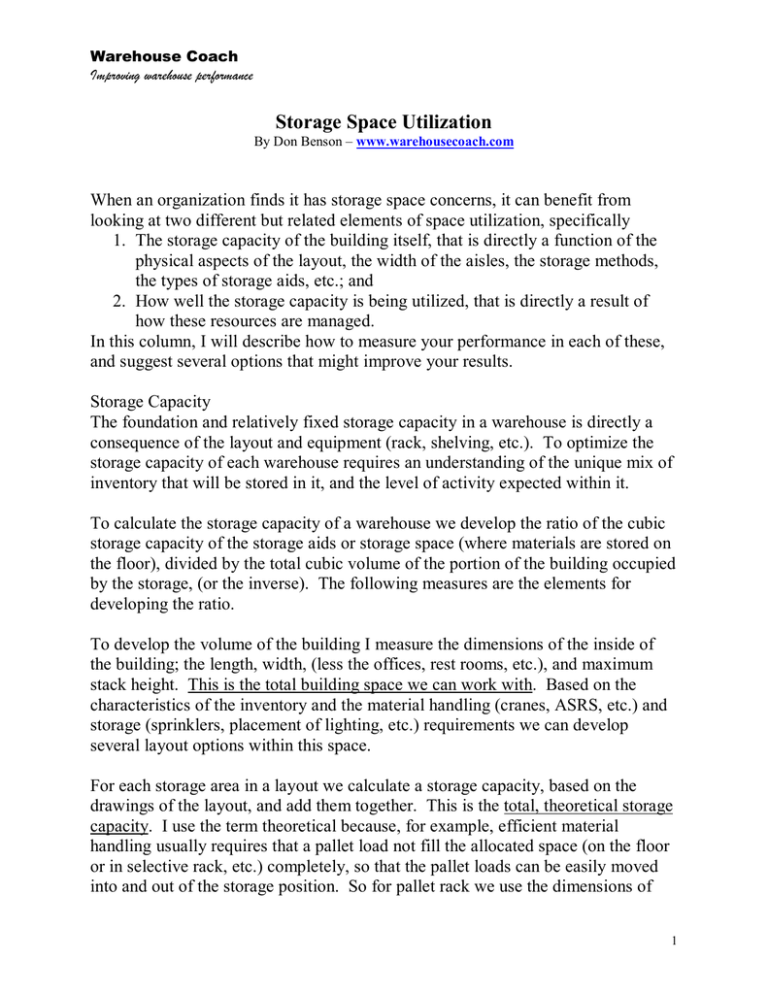
Warehouse Coach Improving warehouse performance Storage Space Utilization By Don Benson – www.warehousecoach.com When an organization finds it has storage space concerns, it can benefit from looking at two different but related elements of space utilization, specifically 1. The storage capacity of the building itself, that is directly a function of the physical aspects of the layout, the width of the aisles, the storage methods, the types of storage aids, etc.; and 2. How well the storage capacity is being utilized, that is directly a result of how these resources are managed. In this column, I will describe how to measure your performance in each of these, and suggest several options that might improve your results. Storage Capacity The foundation and relatively fixed storage capacity in a warehouse is directly a consequence of the layout and equipment (rack, shelving, etc.). To optimize the storage capacity of each warehouse requires an understanding of the unique mix of inventory that will be stored in it, and the level of activity expected within it. To calculate the storage capacity of a warehouse we develop the ratio of the cubic storage capacity of the storage aids or storage space (where materials are stored on the floor), divided by the total cubic volume of the portion of the building occupied by the storage, (or the inverse). The following measures are the elements for developing the ratio. To develop the volume of the building I measure the dimensions of the inside of the building; the length, width, (less the offices, rest rooms, etc.), and maximum stack height. This is the total building space we can work with. Based on the characteristics of the inventory and the material handling (cranes, ASRS, etc.) and storage (sprinklers, placement of lighting, etc.) requirements we can develop several layout options within this space. For each storage area in a layout we calculate a storage capacity, based on the drawings of the layout, and add them together. This is the total, theoretical storage capacity. I use the term theoretical because, for example, efficient material handling usually requires that a pallet load not fill the allocated space (on the floor or in selective rack, etc.) completely, so that the pallet loads can be easily moved into and out of the storage position. So for pallet rack we use the dimensions of 1 Warehouse Coach Improving warehouse performance the rack structure including the area above the top set of beams and calculate a cubic volume. Similarly for shelving we calculate the internal volume of the shelving section. This is not a precise calculation, but the differences between various alternative layouts typically does not justify spending a lot of time getting exact measurements. EXAMPLE: In a recent project the client needed to get better utilization of the storage capacity of an existing, conventional wholesale distribution warehouse. The client had a 20,770 sq ft. warehouse, filled primarily with pallet rack, plus two rows of carton flow rack. The top of the load on the top beam was about 247” high. I calculated the cube of the entire warehouse storage area to be about 427,000 cubic feet (20770’ * 20.6’). I then used the outline dimensions of the rack, or storage area footprint, from the layout drawing and multiplied each times the height of the highest load in that area, e.g., sitting on the top beam of the pallet rack (or flow rack). Then I added the cubic volume for each of the areas and created a total maximum storage capacity of the storage aids in the warehouse. The theoretical storage cube for the client’s warehouse was 118,687 cubic feet. Dividing the building cube into the storage capacity cube we determined that the layout and storage aides used approximately 27.79 % of the building. While that number is typical for a warehouse, it is often a big surprise to operating management. The result usually ranges between 22% and 27%. Warehouses with results outside that range typically have unusual characteristics, pay the price of lower labor productivity, or an error in calculation. This ratio provides the way to help us better understand the importance and tradeoffs in the number and width of aisles, the orientation of the aisles, the size and orientation of the rack and shelving, what is the building clear height that can be used with the existing fire control system, and begin to help us understand the functional and financial consequences of the many other available options, including selective rack, two deep selective rack, push back, drive through, storage and retrieval systems, floor storage, flow rack, etc. Evaluating alternatives requires us to better understand the nature of the inventory to be stored in them and how the warehouse will be used. As we consider alternatives, we can begin to see how important the layout can be and how layout and choice of storage aid addresses only half of the issue. Utilization of Storage Capacity The second measure focuses our attention on how well we use the existing storage capacity, measuring the impact of our choices of material handling equipment, 2 Warehouse Coach Improving warehouse performance labor, methods, procedures, and systems support. This dynamic measure can yield different results as we change with the nature of the inventory, the methods and procedures, the information system support, and can help us monitor how well we are using the storage space available. We calculate this measure as percentage use of the theoretical space available, described above. We can develop a space use percentage in several ways. Often we have to start with a manual method, until the cubic volume of the SKUs has been calculated and available in the computer system. The steps below describe a manual calculation method to use to begin: 1. Using the data from the first measurement ratio calculation, determine the theoretical cubic volume of each logical area of the warehouse. Logical areas could be individual rack rows, floor stack areas, etc.; 2. Estimate the current percentage fill of each logical area, e.g. 30% or 50% or 80%, etc. I usually divide each area into rack rows and estimate the percentage for each row. Note, if you use the outside dimensions of the rack in calculating the storage capacity, even if every location in a rack row is occupied with full pallets, the row could never be more than 90% full; 3. Multiply the percentage occupancy of each area times the theoretical capacity of each area and then add the results together for a total cubic ft. of inventory. (inventory cube); and 4. Divide the calculated inventory cube by the total storage capacity cube to obtain a storage capacity utilization percentage. This calculation also almost always yields a surprising result. I often find that the inventory volume percentage of the storage capacity is seldom greater than 50%. And consequently the inventory cube as a percentage of the building is almost always less than 15%. (50% X 24%=-12.5%) In the client project, we discovered that the client had many SKUs in the inventory that were small, and had devoted full pallet locations to loads that only used a fraction of the actual location cube. By using custom, narrower pallets, they could significantly increase their storage utilization and potentially add more SKUs without changing any other aspect of the storage area. In another situation, we know that the cube use of the storage aids or the building changes over time, mostly for reasons outside of your control, and often as a consequence of seasonal customer demand and buying patterns. You can also 3 Warehouse Coach Improving warehouse performance change use through the aggressive replenishment from random storage to fixed pick positions. With an effective measurement system, you can control how effectively you use the storage capacity, by changing layout, storage aids and methods, operating methods, pallet size, pick method, forward pick location replenishment, and the use of a Warehouse Management System, etc. If you establish a process of measuring and tracking your storage aid utilization throughout the year, at different points in the cycle of your inventory flow, I am sure you will discover both how others impact it and how you can react to better use this resource. Please let me know how you use these measurement ratios, and what you discover about your own warehouse. You can reach me at coach@warehousecoach.com. 4
